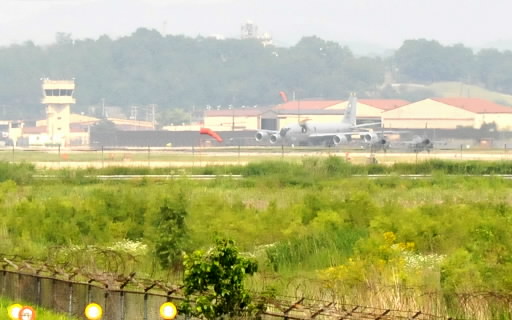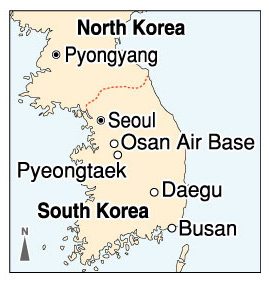Nuclear weapons can be eliminated: Chapter 6, Part 2
Jul. 28, 2009
Chapter 6: Instability in Northeast Asia
Part 2: Reinforcing the nuclear umbrella
by Junichiro Hayashi, Staff Writer
Leaders of U.S. and South Korea put agreement into writing
Booms sounded as fighter planes took off one after another from the U.S. Air Force Osan Air Base. Situated among fields on the outskirts of Pyongtaek, 55 kilometers south of South Korea’s capital of Seoul, it is one of the largest bases in East Asia, and the home of reconnaissance aircraft that conduct surveillance of North Korea.
During the Cold War, nuclear weapons were housed at several U.S. bases in South Korea. At the height of the Cold War nearly 950 tactical warheads, including surface-to-air missiles, are believed to have been in South Korea. According to the Nautilus Institute, a U.S. think tank, there were 14 Nuclear Weapons Accident Response Units in South Korea, including one at Osan.
But in December 1991, after the end of the Cold War, South and North Korea agreed on a joint declaration making the Korean Peninsula nuclear-free. In step with growing sentiment toward reconciliation, the U.S. removed all of its tactical nuclear weapons from South Korea. Since then the U.S. has placed South Korea under its nuclear umbrella like Japan.
In an interview at the National Assembly Building in Seoul, Park Sun-young, 53, a member of the National Assembly from the Liberty Forward Party, the body’s number two opposition party, called for the expansion and reinforcement of the nuclear umbrella. “If North Korea intends to have nuclear weapons, then we must have a nuclear deterrent even stronger than theirs,” she said.
The nation’s leader has begun to take action. Following North Korea’s nuclear test in May, President Lee Myung-bak held a summit with U.S. President Barack Obama on June 16 in which he asked for an assurance of U.S. commitment to the nuclear umbrella. Rather than relying solely on a verbal agreement, the commitment was put in writing, the first time this had been done between the leaders of the two countries.
Ms. Park, however, expressed concern about the document. “The framework of the nuclear umbrella and what it covers are unclear. In response to the level of danger posed by North Korea, what weapons will the U.S. use and how? If this is not stated clearly, the concerns of the people of South Korea will not be allayed.”
Kim Sung-han, 48, a professor of international relations at Korea University in Seoul and a member of the president’s Institute of Foreign Affairs and National Security Council Advisory Body, also supports nuclear deterrence but recognizes the limitations of addressing nuclear weapons with nuclear weapons. “Even if the nuclear umbrella has the ability to inhibit North Korea’s use of nuclear weapons, it does not have the power to bring the North’s nuclear development to a halt,” he said.
But regardless of the effectiveness of the nuclear umbrella, the residents of the town where the base is located are concerned.
The U.S. military is currently reorganizing its bases in South Korea, which are scattered throughout the country. Most of their functions will be consolidated into facilities in Osan and Pyeongtaek, as well as in Daegu and Busan in the south, in an effort to create new strategic points.
Kang Sang-won, 39, is director of the Pyeongtaek Peace Center, a local citizens’ group that opposes the base. “As long as North Korea and the U.S. are at odds, those of us living in the town where the base is located must face the fear of being the target of nuclear weapons,” he said.
The nuclear umbrella will not allay their concerns.
(Originally published on July 12, 2009)
To comment on this article, please click the link below. Comments will be moderated and posted in a timely fashion. Comments may also appear in the Chugoku Shimbun newspaper.









